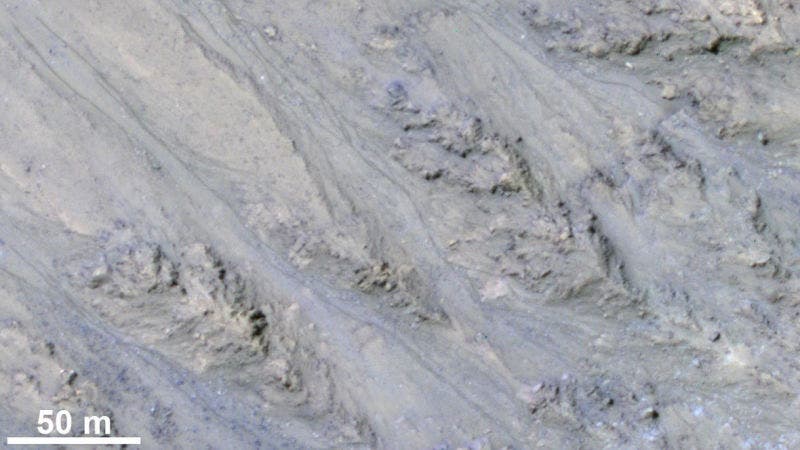In 2015, NASA scientists announced they’d found briny water flowing out of Martian mountain slopes. The news got a lot of people excited, especially about the prospect of finding microbial life — always a possibility when flowing water is involved. But now American and British researchers say we likely got carried away. The features NASA initially identified look and behave more like flowing sand rather than flowing water, the authors report in Nature Geoscience.

The initial discovery was performed by a team of researchers led by Lujendra Ojha of the Georgia Institute of Technology. Ojha and colleagues showed that seasonal dark streaks called “recurring slope lineae” (RSL) appear like spots on the planet’s surface, on the slopes of mountain ridges. Judging from the features captured by NASA’s Mars Reconnaissance Orbiter (MRO) and the spectral analysis that revealed that chemical makeup of the dark streaks, the researchers concluded they were looking at hydrated salts or brine.
On Mars, average temperatures are about -55° C ( -67° F). That’s way too cold for water to stay liquid though salt is known to significantly lower a solution’s freezing temperature. Colin Dundas, a geologist at the US Geological Survey, along with colleagues, analyzed the Martian topology at the site where the RSL were found. The investigation showed that the dark RSL don’t really behave like water. Their length compared to the slope of the hill are better explained by flowing grains of sand, instead. If it were really water, MRO should have seen more water flowing further down the slope, which wasn’t the case.
Another important piece of evidence that supports the hypothesis that the RSL are nothing but sand deals with the so-called ‘angle of repose’. This is the specific angle at which rivulets of sand can form and Dundas’ team showed that the RSL have been observed only on hillsides that reach the angle of repose for sand dunes. Water, on the other hand, should appear on gentler slopes too. So, if it looks and behaves like sand, it likely is.
“We’ve thought of RSL as possible liquid water flows, but the slopes are more like what we expect for dry sand,” Dundas, lead author on the new study, said in a statement. “This new understanding of RSL supports other evidence that shows that Mars today is very dry.”
“The RSL don’t flow onto shallower slopes, and the lengths of these are so closely correlated with the dynamic angle of repose, it can’t be a coincidence,” Alfred McEwen, a professor of planetary geology at the University of Arizona.
That’s not to say that there isn’t any water in those RSL. It’s just that the odds of finding flowing water on the planet just got a lot dimmer. The only way we know for sure is by literally getting some boots wet. In this case, some rover wheels. MRO Project Scientist Rich Zurek cautions, however, that any in-situ expedition needs to take extra precautions not to contaminate the site with Earth-based microbial agents. “A full explanation of how these enigmatic features darken and fade still eludes us. Remote sensing at different times of day could provide important clues,” Zurek said.






